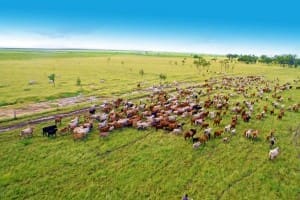THE Federal government’s new Free Trade Agreements, especially that with China, have underlined the huge market for food growing in Asia. However, if Australia’s farmers think that bounty will just drop into their laps, they are wrong.
There are two problems. One is an ominous decline in the capacity of Australia’s farm estate, once of the world’s most productive, to supply. The other is the ‘farmgate’ mentality in the farming community – what’s beyond it is someone else’s problem.
The Asian FTAs include valuable commitments to open markets for Australian agriculture. But the timetables are long term. The rapidly expanding middle-class in Asia, particularly China, is creating new, huge demand now. Is Australian farming positioned to supply this rapidly expanding market?
Productivity
An overview of the performance of our agricultural industries in the last decade is sobering. Productivity over the last decade has averaged 1.3 percent. This is below the global average, certainly lower than in the US and New Zealand where productivity has been above 3 percent.
 Another ominous statistic is that the volume of production was static between 2001 and 2011.
Another ominous statistic is that the volume of production was static between 2001 and 2011.
What is the cause? There will be several factors but one stands out. Land available for farming shrank by 15 percent.
Some might say the record drought in the ‘noughties’ brought all these indicators down. It did not strike the entire continent. Productivity was twice as high in the west and north as the rest of the country.
We do know for a fact that during that decade, state governments imposed significant restrictions on clearing of native vegetation and reduced the flexibility by farmers in the use of their own land. In 2004, the Productivity Commission found this devalued property rights and reduced the capacity farmers to expand production.
‘Creeping’ environmental policy
Water entitlements for farmers from the Murray-Darling system were also reduced by a third, ostensibly to save the environment from what was envisaged as continuing drought. As predicted, the water flows returned; but farmers have not been invited to buy back the water rights. Limits on conversion of forest land (outside conservation areas) to other purposes, such as farming, were also extended.
It has not been a declared policy of any Australian government to reduce the farm estate. This has been the incidental impact of creeping environment policy.
Unless there are changes, this process will continue. The Nature Conservancy, the world’s biggest conservation organisation, has plans to limit land for cattle grazing in the North. WWF also supports this. Its core policy is to reduce the farm estate world-wide – because we eat too much and there is too much farming. Both also plan to turn a huge area in south-western Australia into a nature reserve.
This is a longer-term picture. The immediate challenge to Australian farmers is to capitalise on the burgeoning demand for food by Asia’s middle classes.
Challenge is to smaller farmers
It would be a severe miscalculation if farmers thought Asian markets will automatically increase demand, even from a shrinking farm estate. They will be trading on price and there will be plenty of competition, including from Chinese producers.
The lucrative Asian market is not there for the taking, it is there to be developed. Large farmers get this; the challenge is to small farmers.
Asia’s rapidly expanding middle class is switching to high-protein food and has anxiety about the safety of food.
Chinese consumers don’t want contaminated frozen Chinese berries either. They will pay for safe food. One Australian dairy producer reportedly is selling milk in China at eight times the standard price because consumers trust it as safe.
Chinese investment
Farmers need to invest to develop high-value, specialised food products. They need to access supply chains to Chinese consumers.
China’s three biggest cities hold 92 million people. Eighteen cities are between five and eight million. How does a farmer in Deniliquin know how to reach any of those markets? The answer is to look beyond the farmgate, strike business relationships with Chinese processors and retailers, and, yes, encourage Chinese investment in their farms in Australia.
The Coalition has plans to develop the North. That is a long-term endeavour. But it will not be achieved unless governments put a stop to incidental reduction of the farm estate through misguided conservation policies.
This is justified as conserving biodiversity. But there are already conservation parks all over Australia. Saving endangered species requires targeted strategies, not further expansion of conservation areas. The only species endangered by current policies is farmers.
Alan Oxley is principal of ITS Global. He spoke at this week’s ABARES conference in Canberra.



HAVE YOUR SAY